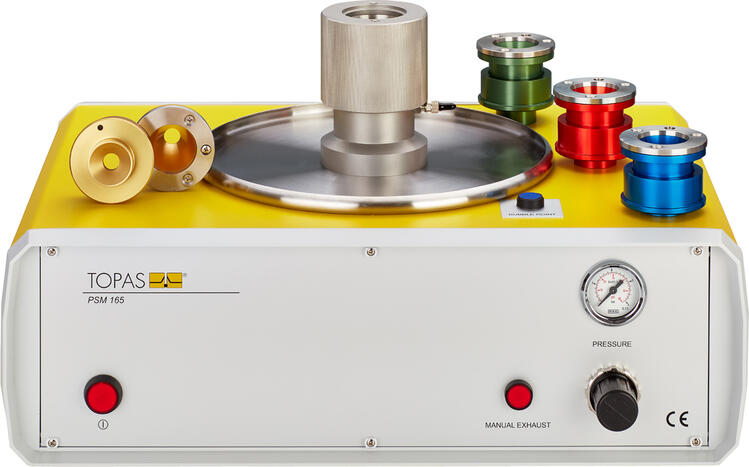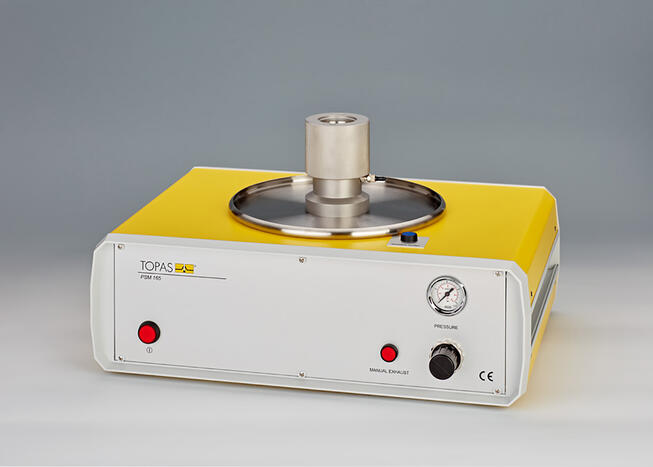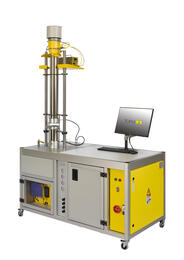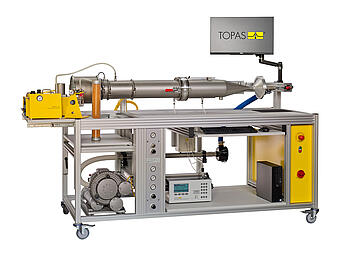PSM 165 Pore Size Meter
PSM 165 Pore Size Meter for analysis of pore size distributions of woven, non-woven fabrics and open-pore samples
The unique PSM 165 Pore Size Meter provides pore size information for a wide range of porous materials with applications in the field of filtration, hygiene and tissue engineering.
Standards
Benefits
- high accuracy especially for pores > 10 µm, particularly relevant for non-woven fabrics and open-pore samples
- open concept for sample holder, manual bubble point measurement is possible, which is necessary for particularly dense samples
- customised sample holder adapted for the measurement of various test specimens
Applications
- barrier effect and germ retention of textiles - multifilament woven
- hygiene - capillary effect and suction power of absorbers of sanitary products
- injection printing - capillary effect and typeface of print-out paper
- cell cultivation - specific inner surface of carrier materials
- filter materials - pressure loss characteristics and fractional efficiency
- quality vontrol and incoming goods inspection
The basic principle of pore size measurements is that liquid filled pores will become gas permeable at a certain gas flow pressure. This initial differential pressure indicates the bubble point of a material.
As real materials contain a range of pore sizes, the bubble point corresponds to the opening pressure of the largest pore. The measured pressure value is dependent on the surface tension of the test fluid used.
By further increasing the gas flow rate, and therefore the pressure drop across the material under test, it is possible to calculate a pore size distribution from these two measured parameters.
The applied measuring principle is in close accordance with ASTM E 1294-89 and ASTM F 316-03 standards. In addition to test liquid Topor, measurements can be carried out with a range of other test liquids. To achieve reliable results the surface tension of the test fluid must be known and a sufficient wetting of the test sample has to be guaranteed.
| Parameter title | Unit | Value |
|---|---|---|
| measurand(s) | - | pore size distribution, gas permeability |
| measuring range, pore size | µm | 0,25 ... 130 |
| operating medium, gas/air - compressed air supply | bar | max. 6 |
| Betriebsmedium, test liquid | - | Topor |
| power supply | V AC | 110 ... 230 |
| weight | kg | 12 |
| dimensions (w × h × d) | mm | 480 x 390 x 310 |
- triple-staged compressed air cleaning assembly
- Topor - test liquid for pore size measurements with pore size analyzer
-
Fan Q., Liang W., Fan T.-T., Li X., Yan S.-Y., Yu M., Ning X. and Long Y.-Z Polyvinylidene fluoride composite nanofibrous filter for high-efficiency PM2.5 capture Composites Communications 22 (2020) 100533,
dx.doi.org/10.1016/j.coco.2020.100533 -
Liu Y., Qian X., Wang L., Qian Y., Bai H. and Wang X. Hierarchical micro/nanofibrous filter for effective fine-particle capture Powder Technology 360 (2020) 0, 1192 - 1199
dx.doi.org/10.1016/j.powtec.2019.11.012 -
Liu Y., Qian X., Zhang H., Wang L., Zou C. and Cui Y. Preparing micro/nano-fibrous filters for effective PM 2.5 under low filtration resistance Chem. Eng. Sci. 217 (2020) 115523,
dx.doi.org/10.1016/j.ces.2020.115523 -
Yang Y., He R., Cheng Y. and Wang N. Multilayer-structured fibrous membrane with directionalmoisture transportability and thermal radiation forhigh-performance airfiltration e-Polymers 20 (2020) 1, 282 - 291
dx.doi.org/10.1515/epoly-2020-0034 -
Zhu F., Su J., Wang M., Hussain M., Yu B. and Han J. Study on dual-monomer melt-grafted poly(lactic acid) compatibilized poly(lactic acid)/polyamide 11 blends and toughened melt-blown nonwovens Journal of Industrial Textiles 49 (2020) 6, 748 - 772
dx.doi.org/10.1177/1528083718795913 -
Ullmann C., Babick F. and Stintz M. Microfiltration of Submicron-Sized and Nano-Sized Suspensions for Particle Size Determination by Dynamic Light Scattering Nanomaterials 9 (2019) 6,
dx.doi.org/10.3390/nano9060829 -
Li X., Wang X.-X., Yue T.-T., Xu Y., Zhao M.-L., Yu M., Ramakrishna S. and Long Y.-Z. Waterproof-breathable PTFE nano- and Microfiber Membrane as High Efficiency PM2.5 Filter Polymers 11 (2019) 4,
dx.doi.org/10.3390/polym11040590 -
Zhu F., Su J., Zhao Y., Hussain M., Yasin S., Yu B. and Han J. Influence of halloysite nanotubes on poly(lactic acid) melt-blown nonwovens compatibilized by dual-monomer melt-grafted poly(lactic acid) Text. Res. J. 89 (2019) 0, 4173 - 4185
dx.doi.org/10.1177/0040517519826926



